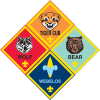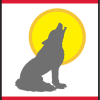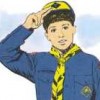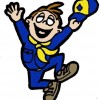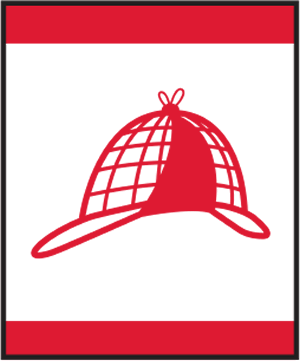 Do you ever think about what you want to do when you grow up? Did you know that everyone uses math, either in their job or in their daily activities or both? Even now you use math every day, even if you don’t think about it. Did you cook anything recently? You had to measure the ingredients. Did you build anything? You had to count and measure the pieces. Do you have a favorite team? The team has won and lost a certain number of games. When you buy something, how do you know if you got the right change? Yes, math is all around you. This adventure helps you explore math, how it really is all around you, and how you can use it to have fun. Let’s look at the world of math.
Do you ever think about what you want to do when you grow up? Did you know that everyone uses math, either in their job or in their daily activities or both? Even now you use math every day, even if you don’t think about it. Did you cook anything recently? You had to measure the ingredients. Did you build anything? You had to count and measure the pieces. Do you have a favorite team? The team has won and lost a certain number of games. When you buy something, how do you know if you got the right change? Yes, math is all around you. This adventure helps you explore math, how it really is all around you, and how you can use it to have fun. Let’s look at the world of math.
Rationale for Adventure
This elective is part of the STEM group and engages the Wolves in some fun math-related activities that have them doing math with a goal of introducing math as a tool that will help them discover relationships in activities that include counting, simple arithmetic, geometric shapes, and code generation.
Requirements
Complete two of the following requirements.
- Complete two of the following:
- With the members of your den or family, make a game with simple materials that requires math to keep score.
- Play a game of “Go Fish for 10s.”
- Do five activities at home, at school, or in your den that use mathematics, and then explain to your den how you used everyday math.
- Make a rekenrek with two rows, and show your den leader or other adult how you would represent the numbers 4, 6, 9, and 14.
- Make a rain gauge or some other measuring device, and use it.
- Complete one of the following:
- With other members of your den or family, identify three different types of shapes that you see in nature.
- With other members of your den or family, identify two shapes you can see in the construction of bridges
- Select a single shape or figure. Observe the world around you for at least a week, and write down where you see this shape or figure and how it is used.
- Complete one of the following:
- With your den, find something that comes with many small, colored items in one package. Count the number of items of each color in your package. Keep track of each color. Then:
- Draw a graph showing the number of items of each color.
- Determine what the most common color is.
- Compare your results to those of the other Scouts’.
- Predict how many items of each color you will find in one more package.
- Decide if your prediction was close.
- With your den or family, measure the height of everyone in the group and see who takes more steps to walk 100 feet.
- Have each member in your den shoot a basketball. Count the number of shots it takes for each Scout to sink five baskets. Make a Graph the number of shots it takes for each boy using 5, 6–10, 11–15, 16–20, or more than 20.
- With your den, find something that comes with many small, colored items in one package. Count the number of items of each color in your package. Keep track of each color. Then:
- Complete one of the following:
- Use a secret code using numbers to send a message to one of your den members or your den leader. Have that person send a message back to you. Be sure you both use the same code.
- Send a message to another member of your den or your den leader using the pig pen code or another code that changes letters into special shapes.
- Practice using a code stick to create and decode messages.
Takeaways for Cub Scouts
- Realization that math is all round us.
- Starting to see math as a fun tool.
- Creativity and deductive reasoning
- A Scout is cheerful, thrifty
Historical Requirements
2015 Handbook Requirements
Wolf Handbook, page 158
Wolf Den Leader Guide, page 97
- Do two of the following:
- With the members of your den or family, make a game with simple materials that requires math to keep score.
- Play a game of “Go Fish for 10s.”
- Do five activities at home, at school, or in your den that use mathematics, and then explain to your den how you used everyday math.
- Make a rekenrek with two rows, and show Akela how you would represent the numbers 4, 6, 9, and 14.
- Make a rain gauge or some other measuring device, and use it.
- Do one of the following:
- With other members of your den or family, identify three different types of shapes that you see in nature.
- With other members of your den or family, identify two shapes you can see in the construction of bridges.
- Select a single shape or figure. Observe the world around you for at least a week, and write down where you see this shape or figure and how it is used.
- Do one of the following:
- With your den, find something that comes with many small, colored items in one package. Count the number of items of each color in your package. Keep track of each color. Then:
- Draw a graph showing the number of items of each color.
- Determine what the most common color is.
- Compare your results to the other boys’.
- Predict how many items of each color you will find in one more package.
- Decide if your prediction was close.
- With your den or family, measure the height of everyone in the group and see who takes more steps to walk 100 feet.
- Have each member in your den shoot a basketball. Count the number of shots it takes to make five baskets. Graph the number of shots it takes for each boy using 5, 6–10, 11–15, 16–20, or more than 20.
- With your den, find something that comes with many small, colored items in one package. Count the number of items of each color in your package. Keep track of each color. Then:
- Do one of the following:
- Use a secret code using numbers to send a message to one of your den members or your den leader. Have that person send a message back to you. Be sure you both use the same code numbers.
- Send a message to another member of your den or your den leader using the pig pen code or another code that changes letters into special shapes.
- Practice using a block cipher to decode a message.

